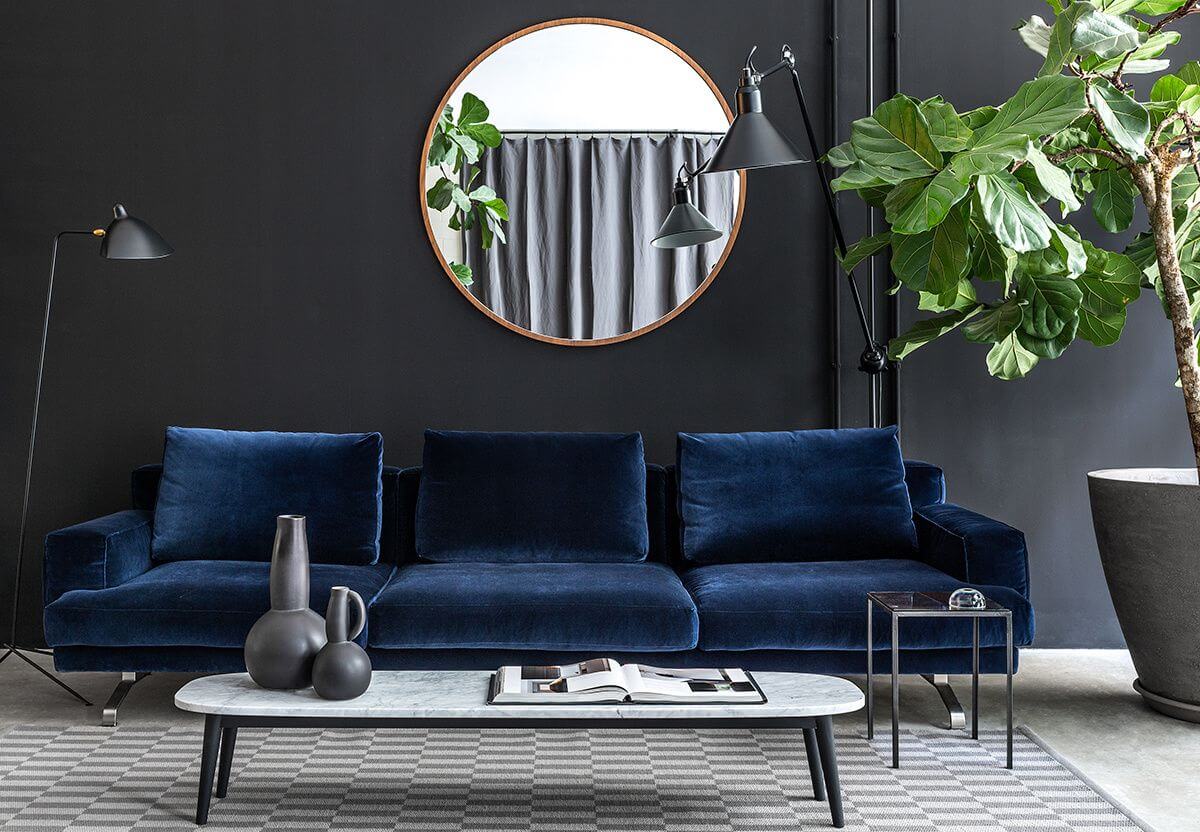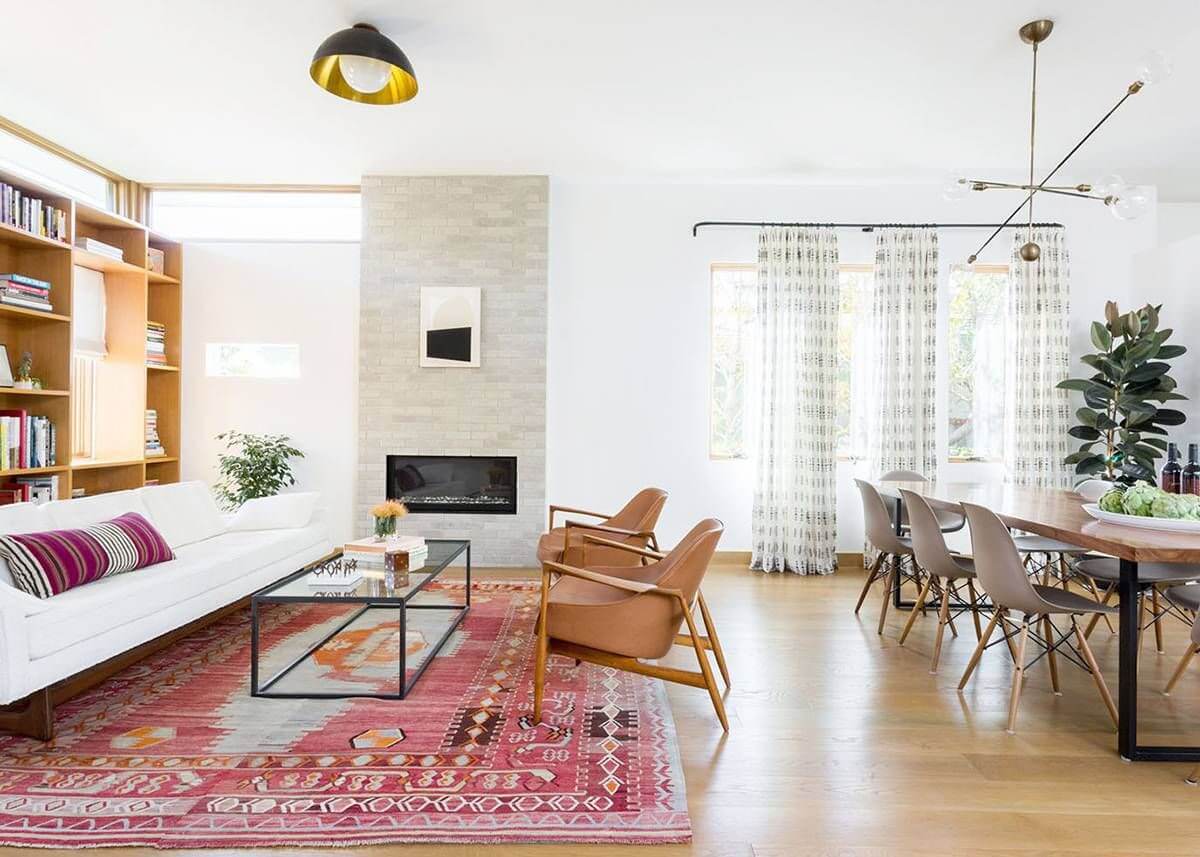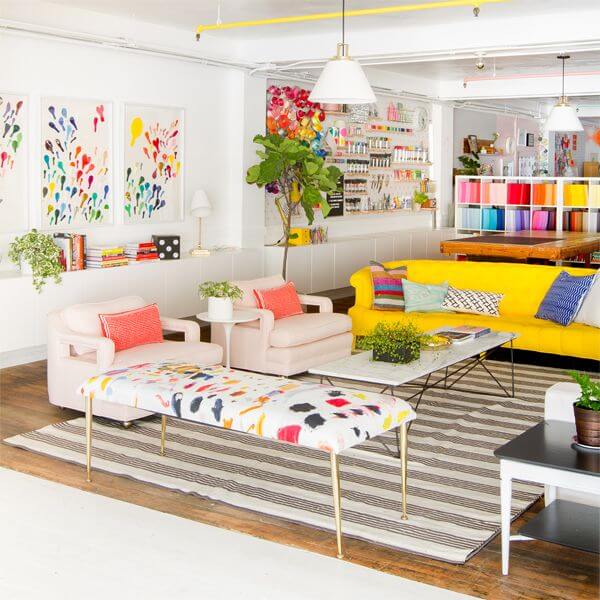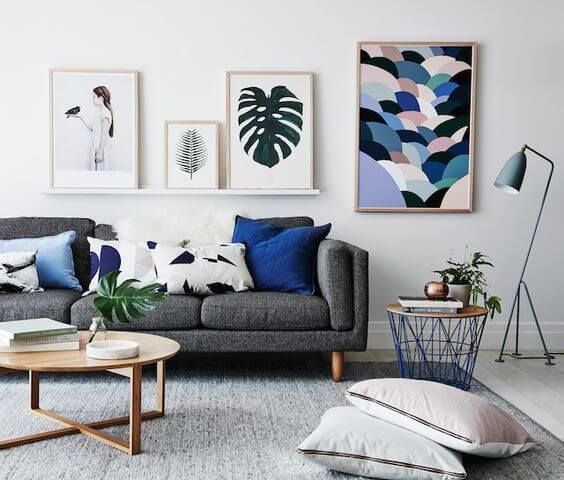Impossible to resist, the more or less intense shades of blue, which has become a must in interior design in a few years. Color has made its way to the living room to envelop us in its pigments, sometimes comforting, sometimes refreshing. Betting on blue in the living room makes it possible to obtain very different results depending on the shade chosen. A dragee or slightly azure paint accentuates the natural light, while a navy paint more easily draws a hushed atmosphere. And when it slips into the decor via a velvet sofa, the color invites us to dive into a fantasy ocean. It is therefore not surprising to see the variations of blue dethroning the classic gray and taupe in living spaces. Easier to handle, they even make it possible to tame the shades that have long been shunned in interiors. So many qualities that explain the growing success of this shade with a strong character.
Formerly reserved for night rooms for its enveloping side, blue has nevertheless conquered the lines of the living room with its many variations. The bluish shades can embrace the slow aesthetic of a room where natural materials dominate, but also reinforce the industrial style of an architecture (living room nestled in a rehabilitated factory, in the spirit of a workshop or loft type). The color embodies a good compromise between a neutral that could lack personality and a shade that is too difficult to assume on a daily basis – especially because blue goes through the decades without going out of style. It also makes it possible to breathe charm into new constructions, thanks to its changing pigments depending on the time of day. Its derivatives, duck blue, ultramarine, cerulean, electric or cyan, to name but a few, offer us a certain freedom to embellish the living room. Even if the lighter ones are recommended for a Scandinavian atmosphere, they can be contrasted with a section of smalt wall which completely revisits the genre. The proof with these 13 living rooms where blue makes all the difference.
1- The intense blue base sits the living room
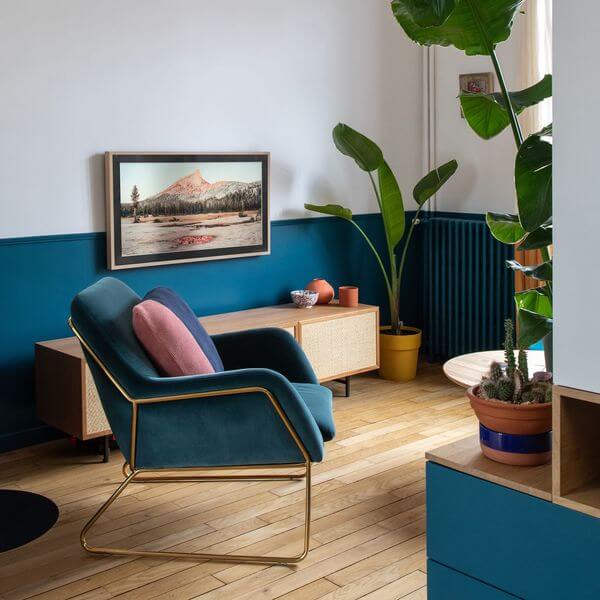
Certain derivatives of classic blue are to be preferred to warm up the atmosphere of a living space. A deep shade like the blue of this renovated house makes it possible in particular to rebalance an overly generous volume; just as she is able to delimit a “cocoon” living room within an open plan. Concentrating the paint in the basement is an enlightened choice with this type of blue: it brings the warmth that was lacking in the living room area but in no way diminishes the beautiful light. The white placed in the upper part thus preserves the light, while the blue outlines the lines of the decoration.
2- A couture line enhances the softness of sky blue
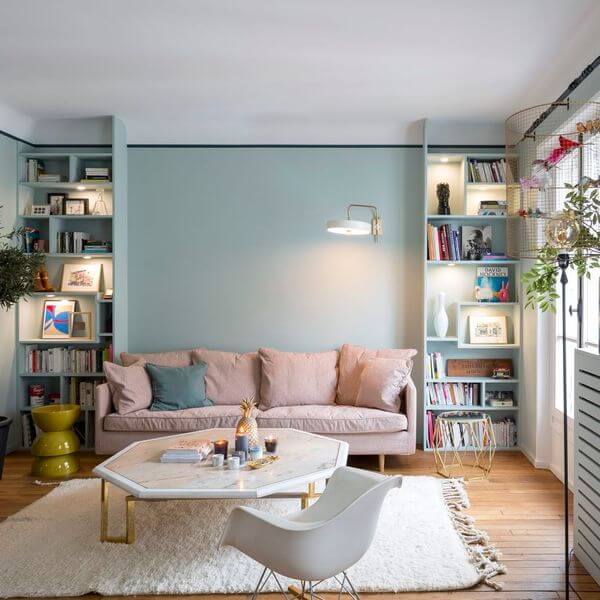
From one shade to another, blue can offer diametrically opposed renderings. It is precisely this adaptability that makes it an ideal color to determine the atmosphere of the living room. If navy or night are known for their character, sky blue is acclaimed for its softness. Applied to all the walls, it transforms the space into a cotton bubble where it is good to meet. This light blue blends seamlessly with powder pinks and other greiges, but needs to be shaken up by a more distinct shade. A black band, painted at the edge of the ceiling or at the level of the base, allows precisely to move away from the first degree.
3- Create depth with a dark shade
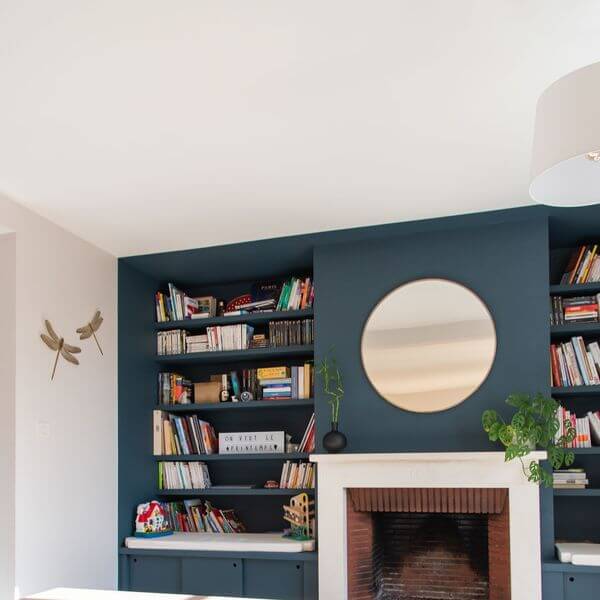
Underestimating the “technical” power of color is a mistake many of us make. Yet used wisely, some paint scan modulate the existing volume, without affecting the square meters or the layout of the partitions. The darkest pigments of blue, most often represented by teal or midnight blue, create unprecedented visual depth when concentrated on a single wall in the living room. Working on the accent color makes it possible to draw the eye towards the back of the room – and all the more so if the other walls have kept a white dress. These dark blues are also easier to assume than a black one.
4- The shades of blue invite themselves via the furniture
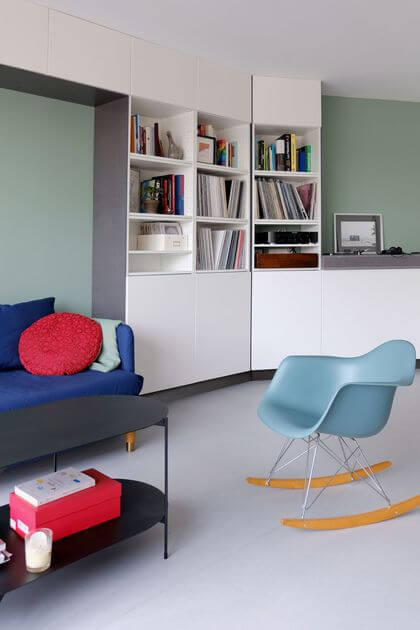
Even if we naturally think of painting to slip a few bluish notes into a living room, it is also possible to concentrate the color on the furniture to benefit from its assets. For example, a corduroy or cotton sofa remains the best way to tame the intensity of the Klein. Betting everything on the furniture also allows you to combine several shades of blue without falling into the trap of the total look. It is a tonality which combines willingly with its congeners, such as green, already widespread on the walls of our homes. The living room, then oscillates between these two neighboring palettes, for a resolutely trendy decoration.
5- Fittings underlined by a (become) iconic blue
![]()
Reinterpreted over the years and trends, blue enjoys an unparalleled reputation among professionals. Both artists and interior designers have contributed to making some of its variations design essentials – like Sarah blue, upgraded by decorator Sarah Lavoine in the space of a decade. Pulling slightly on duck blue, the color alone creates the atmosphere of a living room. Just put it on a bookcase or custom-made carpentry to understand its full potential – it seems warm even though it is a “cold” shade according to the chromatic circle. Or how a blue can become iconic.
6- Scandinavian atmosphere in the pastel living room
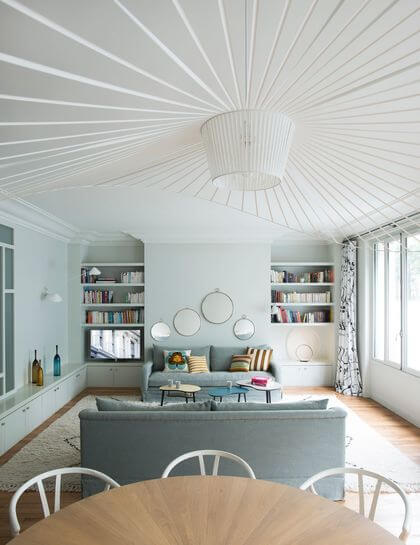
Under the impetus of the Nordic style, blue gets rid of its contrasting pigments to approach pastels as closely as possible. He then proposes to color the living spaces without losing an ounce of luminosity. This very toned down blue lays a soft veil on the walls, forming a pretty decorative base. Some criticize it for its lack of warmth and do not dare invite it to the living room – in reality, it is enough to counterbalance this weakness with cozy materials such as curly wool, velvet, thick cotton, to draw a cocoon with Scandinavian influences assumed.
7- When blue flirts with purple pigments
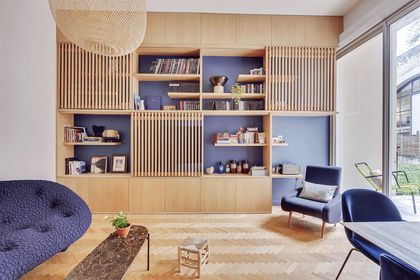
Choosing a dominant blue also allows you to merge several decorative desires. It remains timeless enough to match fans of sober tones, and at the same time offers original shades that delight lovers of color (a godsend in the living room where the tastes of the whole household must cohabit). In this family living space, the blue seems enhanced with a hint of purple that makes all the difference. The slightly purplish reflections affirm a character that is more difficult to find in navy, sky blue, traditionally available in interiors. Upon contact with it, the living room takes on a more contemporary.
8- Wrapping yourself in a monochrome painted blue
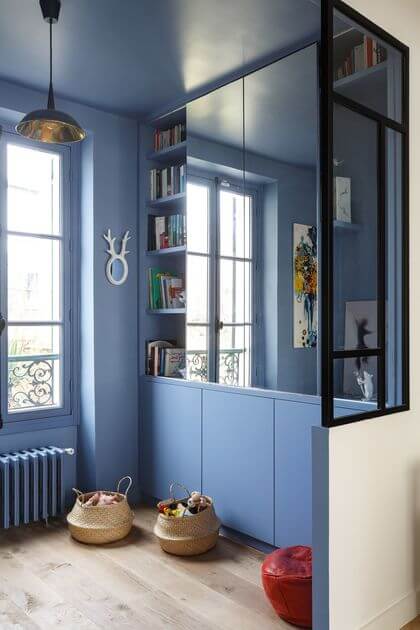
Blue is one of the rare colors to bend to monochromes and other monochromes without (too much) difficulty. Easy to handle, it allows you to compose a tone-on-tone decoration where the walls, the ceiling, the woodwork and even sometimes the furniture offer a unique palette… to the point of transforming the living room into a cocoon. Adopting a strong, but slightly painted blue is essential to create a comforting and cozy atmosphere in the TV corner. Pastel tones are too cold to take on such a function, and on the contrary, a sharp tone like indigo or Majorelle lacks a bit of softness.
9- Enhanced architecture thanks to the lightness of blue
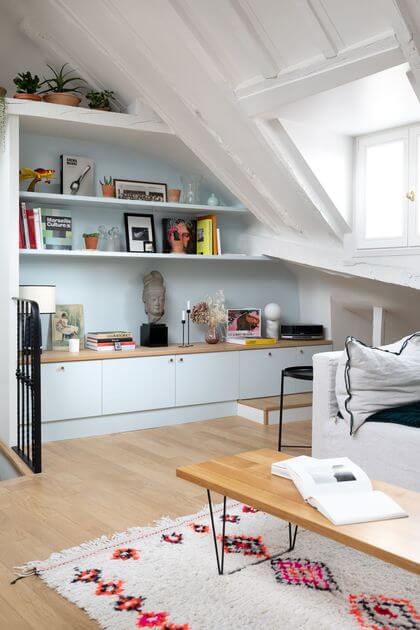
It is not easy to determine the most suitable color to highlight a unique architecture. While white helps avoid mistakes, it also lacks originality – that’s why many of us turn to variations of blue. Chosen fairly light, the bluish tint emphasizes the primary assets of a living room (mouldings, attics, or beams with pretty irregularities) without eclipsing the volume. The smoky or dragée blues also preserve natural light because they work as a light stain on the walls and fittings – an essential point with an atypical architecture where the luminosity must be maximum.
10- Betting on wallpaper to introduce color
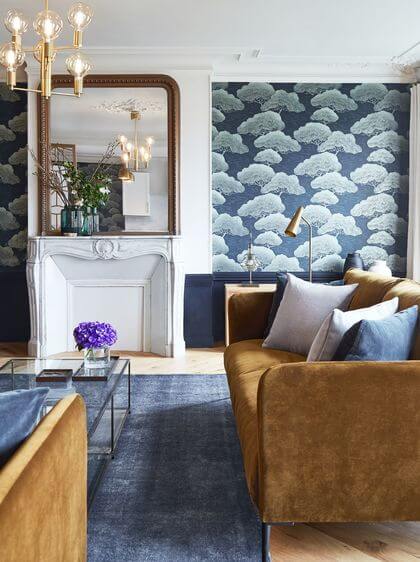
Painting is far from essential for introducing color into a living room because wallpapers have also taken on this role for a few years. These alternative coverings precisely make it possible to invite blue in a less classic form around the sofa. The shade can be dominant on the decor, like a colored background, or punctuate the print with its intense pigments. Betting on a wallpaper also helps to anchor blue in a singular aesthetic – the patterns determine the dominant style and therefore make the color bend to these expectations. Thus, she becomes Japanese, baroque, nature or even ethnic with regard to the print.
11- Blue gains in character by approaching black
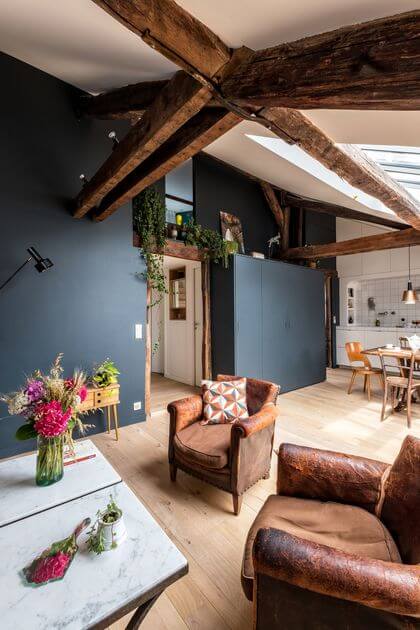
Daring to contrast is not always easy in the living room. For fear of getting bored, we tend to favor the lighter versions of blue to the detriment of dark ones. Reputed to be warmer and more enveloping, these shades above all make it possible to affirm the character of the inhabitants. Midnight blues or midnight, close to black, bring the intensity that is sometimes lacking in the decoration of our interiors. They create a unique depth and sublimate the living room with their bluish reflections, more or less visible depending on the sunshine. If the total dark look can be difficult to tame, it is enough to balance the accent wall with a clear dominant on the other walls.
12- A duck blue sets the tone for the living room
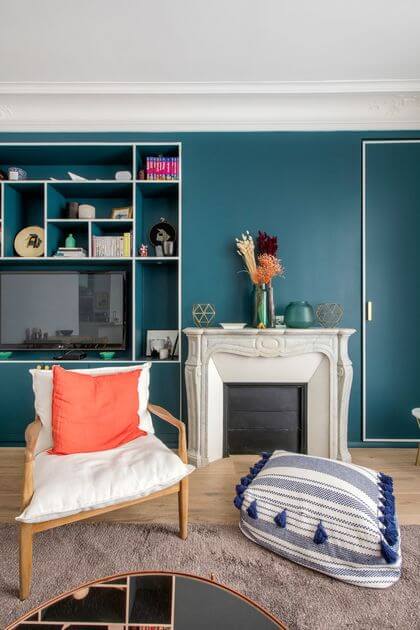
Among all the possible variants of the color, duck blue seems to be essential in many contemporary living rooms. Its assertive temperament allows it to add a personal stamp in a few brushstrokes, which explains the growing enthusiasm for its dark pigments. And as this color combines the trend of green with the timelessness of blue, it colors the contours of the living room with precision. Adding a touch of white to the openings, the edges of the fittings and to the ceiling, is however recommended to compensate for the dark side of duck blue.
13- Nuanced niches affirm the personality of the living room
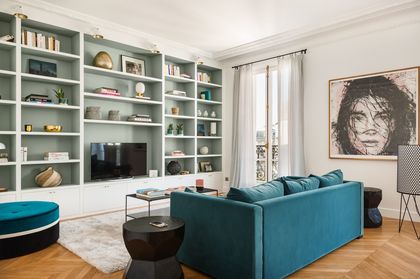
Laying the paint should never be left to chance. In this family living room, only the library enhanced with blue niches stands out from the white ensemble. The color was strategically placed to emphasize the generous dimensions and depth of the shelves, without, however, breaking the harmony of the room (the slices kept in white made it possible to confuse the layout with the partition). In the background, the niches subtly introduced blue, it was the furniture that then accentuated its presence. Proof that targeted notes of blue are enough to take advantage of its character in the heart of a home.
